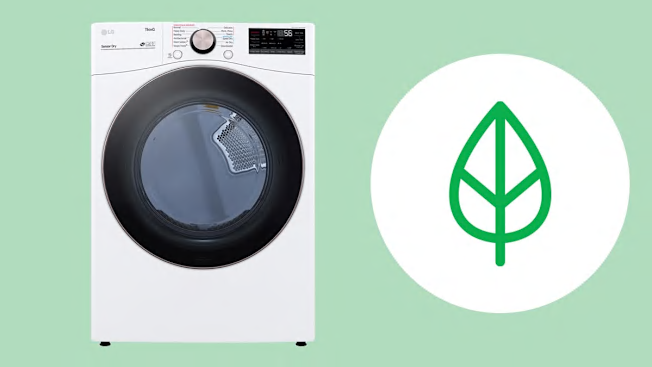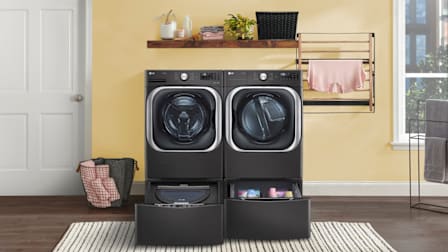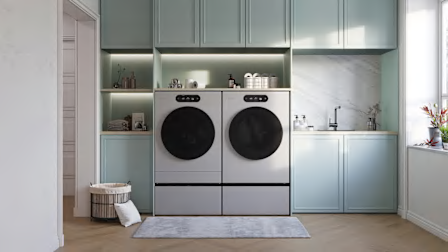Best Eco-Friendly Clothes Dryers of 2026
Our Green Choice label identifies dryers that have the least impact on the environment
When you shop through retailer links on our site, we may earn affiliate commissions. 100% of the fees we collect are used to support our nonprofit mission. Learn more.

Clothes dryers tumble and emit heat for as long as it takes to dry your laundry—and sometimes longer. This can take a toll on your clothes, your utility bills, and Mother Earth.
But not all modern dryers have the same environmental impact. Clothes dryers that are energy-efficient, use fewer resources in their manufacture, and are reliable and long-lasting can contribute to a more sustainable household.
And that matters. In a Consumer Reports nationally representative survey of 2,000 adults from March 2024, 45 percent of those who bought large appliances said sustainability was a top or high priority when they shopped for them. When we asked them which aspects of sustainability are most important when they buy home products, 68 percent said product durability, and 55 percent said water and energy efficiency. Twenty-five percent said a product’s eventual disposal or recyclability was important to them.
CR’s Green Choice designation, marked by a green leaf in our ratings, addresses those concerns by evaluating a dryer’s overall environmental affect based on three criteria: energy, design characteristics, and durability. Green Choice dryers are those that dry clothes effectively using less energy, require fewer resources to make, produce fewer emissions in their manufacture and shipping, and are durable and reliable. The designation informs shoppers about more environmentally friendly choices and encourages manufacturers to create high-performing, efficient, reliable, and durable appliances.
Best Eco-Friendly Electric Dryers
Best Eco-Friendly Gas Dryers
Best Eco-Friendly Compact Dryers
What Makes a Dryer a Green Choice?
CR’s Green Choice program assesses a product’s environmental impact throughout its life cycle—from manufacture to distribution, use, and eventual disposal. Green leaf products attain Green Choice scores if they rank in the top 20 percent of those evaluated.
Currently, the data is recalculated once a year to reassess the performance of existing models and add new models to the program. As more eco-friendly products enter the market, some models identified as Green Choice may lose that designation as other more environmentally friendly models take their place.
Whether a dryer receives a green leaf rating depends on a variety of key environmental-related factors, including the following:
- Drying performance: We consider each dryer’s score in our performance tests, which evaluate how well it dries laundry loads of varying weights and fabrics.
- Energy use: We calculate the amount of electricity and/or gas required for the dryer to complete a load.
- Brand reliability: We use our brand reliability scores to identify which dryers tend to remain in service for longer periods. Longer-lasting machines minimize waste and demand for new resources.
- Warranty: Most dryers come with a one-year warranty on parts and labor. (Speed Queen is an exception, with warranties of five to seven years.) Our Green Choice calculation assigns greater weight to models that offer longer warranties.
“By focusing on these aspects, clothes dryers can significantly contribute to a more sustainable household, balancing functionality with environmental responsibility,” Whitehurst says. “Further, the life cycle of a clothes dryer can be managed to promote environmental sustainability, ensuring a lower impact on natural resources and ecosystems.”
Why Choose a Green Choice Dryer?
Dryers are among the costliest and most energy-consuming appliances in a household, accounting for 3.3 percent of total U.S. residential energy use, according to the Department of Energy. Per unit, electric dryers consume about 782 kilowatt hours each year while gas dryers use about 2.28 million Btu/hr. a year, according to DOE data.
That doesn’t account for other environmental factors, including the resources required to build and ship them, the carbon cost of transporting them to stores and delivering them to consumers, and the pileup of discarded appliances in landfills.
Earlier this year, the Department of Energy rolled back new washer and dryer efficiency standards that were projected to save households in the U.S. $2.2 billion per year on utility bills (an 11 percent energy savings) while significantly cutting energy waste and harmful carbon pollution. CR supported those new regulations (scheduled to take effect in 2028) as a win-win for consumers.
While many high-end machines are already quite energy-efficient, without stricter standards, lower-tier appliances will continue to waste energy. “The challenge is, how do you eliminate the lower-performing appliances altogether and get manufacturers to raise the bar on their appliances and stop passing the costs onto the consumer?” Whitehurst says.
The good news is that more Energy Star certified dryers—which use 20 percent less energy than standard dryers—have appeared on the market in recent years. According to Energy Star, if all dryers sold in the U.S. were Energy Star certified, consumers could collectively save more than $1.5 billion per year in utility costs and prevent greenhouse gas emissions equivalent to those from over 2 million vehicles. You can find Energy Star certified products and energy rebate offers at energystar.gov.
































